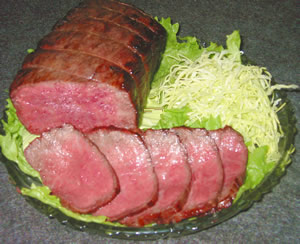It has been years since my Subway sandwich artist days, but I think I could still make a delicious sub if put behind the counter. I worked there for over three years, during which time I noticed a few odd things. One thing was the roast beef. There was always some green gasoline-like sheen on the slices of deli meat (see right). Whenever I had to make a sub that had roast beef I’d get nervous and concerned the customer would ask what it was – I had no idea – until today.
When reading a story in the Sun Chronicle Online about a Massachusetts Subway’s green roast beef, the memories came back to me and I decided to do some investigating.
A co-worker who worked in a meat laboratory explained to me, and this University of Saskatchewan paper on meat colour agrees, that the odd colour I was seeing was likely due to light reflections on sliced meat muscle fibers (which is not a food safety issue).
 From the paper,
From the paper,
Iridescence is a common problem in sliced roast beef and ham products. The dominant color is frequently green and consumers sometimes confuse this with green myoglobin pigments associated with microbial growth. The iridescence of meat products is produced by a combination of the angle of incidence of the light on the muscle fibres and the wetness of the surface. If the fibres are pulled slightly out of alignment during slicing, the light strikes the fibre at an angle scattering light which
appears as the rainbow or greenish color on the surface of the meat.
Whether or not this explains the green on the Massechusetts Subway’s roast beef, I do not know, but does answer a question I forgot I had.

 State epidemiologist Dr. Tom Safranek said the outbreak was caused by roast beef served at a reception hall in Sarpy County for a private gathering of 50 to 60 people on March 26. Safranek further noted the meat was prepared at a person’s home and brought to the event, but he would not say where the meal was served or what the gathering was for.
State epidemiologist Dr. Tom Safranek said the outbreak was caused by roast beef served at a reception hall in Sarpy County for a private gathering of 50 to 60 people on March 26. Safranek further noted the meat was prepared at a person’s home and brought to the event, but he would not say where the meal was served or what the gathering was for.